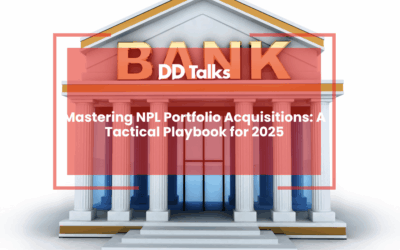NPL Management in Spanish Banking
- AI and machine learning are transforming NPL management, enabling more accurate risk assessment and predictive analytics
- Digital platforms and automation tools are crucial for improving borrower engagement and streamlining recovery workflows
- Real-time portfolio monitoring and advanced analytics provide financial institutions with proactive management capabilities
- Technological innovations are driving significant improvements in recovery rates, operational efficiency, and regulatory compliance
- The future of NPL servicing in Spain depends on continuous technological investment and integration of cutting-edge solutions
The Spanish banking sector is rapidly evolving, with technology playing a pivotal role in modernizing non-performing loan management strategies. Banks that embrace digital transformation and innovative technologies will be best positioned to navigate the complex NPL landscape effectively.
Table of Contents
- The Current State of NPL Management in Spanish Banking
- Key Technologies Driving NPL Servicing Innovation
- How AI is Transforming Debt Collection Strategies
- Digital Platforms Revolutionizing Borrower Engagement
- Automation Tools Streamlining NPL Recovery Workflows
- Real-time Portfolio Monitoring and Analytics
- Regulatory Compliance and Reporting Innovation
- Future Trends and Implementation Strategies
The Current State of NPL Management in Spanish Banking
The fintech for NPL servicing has become increasingly crucial in Spain’s banking sector, where financial institutions face mounting pressure to efficiently manage non-performing loans. Traditional NPL management methods have proven insufficient in handling the complex challenges of modern debt recovery, creating an urgent need for technological transformation. Spanish banks are actively seeking innovative solutions to streamline their NPL management processes while maintaining regulatory compliance and improving recovery rates.
The Spanish banking sector has witnessed significant changes in NPL handling, with industry events like NPL Days España showcasing the latest technological advancements. These developments are reshaping how financial institutions approach debt collection and management, moving away from manual processes towards more sophisticated, technology-driven solutions.
Key Technologies Driving NPL Servicing Innovation
AI and machine learning applications are revolutionising NPL management in Spain, offering unprecedented capabilities in data analysis and decision-making. Digital NPL management platforms have emerged as comprehensive solutions, integrating various technologies to create efficient, automated workflows. Cloud-based solutions provide scalability and accessibility, whilst process automation tools reduce manual intervention and human error.
Data analytics capabilities have become fundamental in modern NPL servicing, enabling banks to make data-driven decisions and predict borrower behaviour more accurately. These technological innovations are transforming how Spanish financial institutions handle their NPL portfolios, leading to improved recovery rates and reduced operational costs.
How AI is Transforming Debt Collection Strategies
AI in debt collection Spain has revolutionised traditional recovery approaches through advanced predictive analytics and automated borrower segmentation. Machine learning algorithms analyse vast amounts of historical data to identify patterns and predict default probability, enabling proactive intervention strategies. Smart communication systems powered by AI optimise contact timing and channel selection, significantly improving engagement rates.
Risk assessment models have become more sophisticated, incorporating multiple data points to create accurate borrower profiles and customised collection strategies. This technology-driven approach has led to more successful debt resolution outcomes while maintaining positive borrower relationships.
Digital Platforms Revolutionizing Borrower Engagement
Modern digital platforms have transformed borrower engagement through self-service portals and omnichannel communication capabilities. These platforms offer convenient payment flexibility options and enhanced customer experience, making it easier for borrowers to manage their obligations. The integration of digital NPL management platforms has significantly improved communication efficiency and borrower satisfaction.
These platforms provide real-time access to account information, payment history, and settlement options, empowering borrowers to take control of their debt resolution journey. The result is increased engagement rates and improved collection outcomes through more transparent and accessible communication channels.
Automation Tools Streamlining NPL Recovery Workflows
Loan recovery automation tools have become essential in streamlining NPL management processes. These tools optimise workflow management, automate document processing, and improve resource allocation. Advanced document management systems reduce manual handling while ensuring accuracy and compliance with regulatory requirements.
The implementation of automated workflows has led to significant improvements in processing times and reduced operational costs. These efficiency gains allow NPL servicing teams to focus on more complex cases requiring human intervention while routine tasks are handled automatically.
Real-time Portfolio Monitoring and Analytics
Modern NPL portfolio management systems provide comprehensive real-time monitoring capabilities and sophisticated analytics tools. Early warning systems help identify potential defaults before they occur, while portfolio valuation tools enable more accurate assessment of NPL assets. These systems support better decision-making through advanced analytics and reporting capabilities.
The integration of real-time monitoring tools has transformed how financial institutions track and manage their NPL portfolios, enabling more proactive management strategies and improved recovery outcomes.
Regulatory Compliance and Reporting Innovation
Automated compliance checks and real-time reporting capabilities have revolutionised regulatory compliance in NPL management. These innovations ensure consistent adherence to regulatory requirements while reducing the resource burden of compliance monitoring. Risk management tools provide comprehensive oversight and control mechanisms.
The maintenance of detailed audit trails through automated systems ensures transparency and accountability in all NPL management activities. This technological approach to compliance has significantly reduced the risk of regulatory breaches while improving reporting accuracy and efficiency.
Future Trends and Implementation Strategies
The future of NPL management in Spain continues to evolve with emerging technologies and innovative approaches. Implementation strategies focus on seamless integration of new technologies with existing systems, following industry best practices. Financial institutions are increasingly recognising the importance of investing in tech trends in NPL management to maintain competitive advantage.
ROI expectations for technological implementations remain strong, driven by demonstrated improvements in recovery rates and operational efficiency. The continued evolution of NPL servicing technology promises further innovations and improvements in the coming years.
Frequently Asked Questions
- What are Non-Performing Loans (NPLs) in the Spanish Banking Sector?
- Non-Performing Loans are credit obligations where borrowers have failed to make scheduled payments for an extended period, typically 90 days or more. In the Spanish banking sector, NPLs represent a significant challenge, with financial institutions increasingly adopting technological solutions to manage and recover these problematic assets.
- How is AI Transforming NPL Management in Spain?
- AI is revolutionizing NPL management through advanced predictive analytics, automated borrower segmentation, and sophisticated risk assessment models. Machine learning algorithms analyze historical data to predict default probabilities, optimize communication strategies, and create personalized debt resolution approaches.
- What Technologies Are Driving NPL Servicing Innovation?
- Key technologies include AI and machine learning, cloud-based solutions, digital management platforms, advanced data analytics, automation tools, and real-time monitoring systems. These technologies enable more efficient, data-driven approaches to NPL management and recovery.
- How Do Digital Platforms Improve Borrower Engagement?
- Digital platforms provide self-service portals, omnichannel communication, real-time account access, and flexible payment options. These features empower borrowers by offering transparency, convenience, and more personalized debt management experiences.
- What Are the Benefits of Automation in NPL Recovery?
- Automation tools streamline workflow management, reduce manual processing, improve accuracy, ensure regulatory compliance, and lower operational costs. They enable NPL servicing teams to focus on complex cases while routine tasks are handled automatically.
- How Are Spanish Banks Addressing Regulatory Compliance in NPL Management?
- Banks are implementing automated compliance checks, real-time reporting tools, and comprehensive risk management systems. These technologies ensure consistent regulatory adherence, maintain detailed audit trails, and reduce the risk of compliance breaches.
- What Are the Future Trends in NPL Management Technology?
- Future trends include continued investment in AI, machine learning, advanced analytics, seamless technology integration, and more sophisticated digital platforms. The focus is on improving recovery rates, operational efficiency, and creating more customer-centric debt resolution strategies.
Regulatory & Compliance Trends Shaping the NPL Market



0 Comments